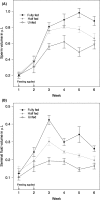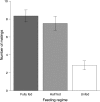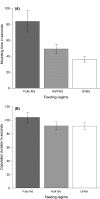Condition-dependent ejaculate production affects male mating behavior in the common bedbug Cimex lectularius
- PMID: 27066237
- PMCID: PMC4797159
- DOI: 10.1002/ece3.2073
Condition-dependent ejaculate production affects male mating behavior in the common bedbug Cimex lectularius
Abstract
Food availability in the environment is often low and variable, constraining organisms in their resource allocation to different life-history traits. For example, variation in food availability is likely to induce condition-dependent investment in reproduction. Further, diet has been shown to affect ejaculate size, composition and quality. How these effects translate into male reproductive success or change male mating behavior is still largely unknown. Here, we concentrated on the effect of meal size on ejaculate production, male reproductive success and mating behavior in the common bedbug Cimex lectularius. We analyzed the production of sperm and seminal fluid within three different feeding regimes in six different populations. Males receiving large meals produced significantly more sperm and seminal fluid than males receiving small meals or no meals at all. While such condition-dependent ejaculate production did not affect the number of offspring produced after a single mating, food-restricted males could perform significantly fewer matings than fully fed males. Therefore, in a multiple mating context food-restricted males paid a fitness cost and might have to adjust their mating strategy according to the ejaculate available to them. Our results indicate that meal size has no direct effect on ejaculate quality, but food availability forces a condition-dependent mating rate on males. Environmental variation translating into variation in male reproductive traits reveals that natural selection can interact with sexual selection and shape reproductive traits. As males can modulate their ejaculate size depending on the mating situation, future studies are needed to elucidate whether environmental variation affecting the amount of ejaculate available might induce different mating strategies.
Keywords: Feeding behavior; mating behavior; reproductive physiology; sperm ecology; sperm physiology.
Figures



Similar articles
-
Male mating rate is constrained by seminal fluid availability in bedbugs, Cimex lectularius.PLoS One. 2011;6(7):e22082. doi: 10.1371/journal.pone.0022082. Epub 2011 Jul 11. PLoS One. 2011. PMID: 21779378 Free PMC article.
-
The effect of mating history on male reproductive ageing in Drosophila melanogaster.J Insect Physiol. 2018 Nov-Dec;111:16-24. doi: 10.1016/j.jinsphys.2018.10.003. Epub 2018 Oct 9. J Insect Physiol. 2018. PMID: 30312587
-
Sexual selection and sperm quantity: meta-analyses of strategic ejaculation.Biol Rev Camb Philos Soc. 2011 Nov;86(4):863-84. doi: 10.1111/j.1469-185X.2011.00175.x. Epub 2011 Mar 17. Biol Rev Camb Philos Soc. 2011. PMID: 21414127 Review.
-
Divergent allocation of sperm and the seminal proteome along a competition gradient in Drosophila melanogaster.Proc Natl Acad Sci U S A. 2019 Sep 3;116(36):17925-17933. doi: 10.1073/pnas.1906149116. Epub 2019 Aug 20. Proc Natl Acad Sci U S A. 2019. PMID: 31431535 Free PMC article.
-
Effects of nutrient limitation on sperm and seminal fluid: a systematic review and meta-analysis.Biol Rev Camb Philos Soc. 2019 Oct;94(5):1722-1739. doi: 10.1111/brv.12524. Epub 2019 Jun 19. Biol Rev Camb Philos Soc. 2019. PMID: 31215758
Cited by
-
Age-related mating rates among ecologically distinct lineages of bedbugs, Cimex lectularius.Front Zool. 2023 Jul 28;20(1):25. doi: 10.1186/s12983-023-00505-z. Front Zool. 2023. PMID: 37507793 Free PMC article.
-
Despite genetic isolation in sympatry, post-copulatory reproductive barriers have not evolved between bat- and human-associated common bedbugs (Cimex lectularius L.).Front Zool. 2023 Nov 10;20(1):36. doi: 10.1186/s12983-023-00514-y. Front Zool. 2023. PMID: 37950221 Free PMC article.
-
All or nothing: Switch to high current reproductive investment under risk of starvation in male kelp crab.Ecol Evol. 2020 Mar 7;10(7):3383-3391. doi: 10.1002/ece3.6131. eCollection 2020 Apr. Ecol Evol. 2020. PMID: 32273995 Free PMC article.
-
Seminal fluid and accessory male investment in sperm competition.Philos Trans R Soc Lond B Biol Sci. 2020 Dec 7;375(1813):20200068. doi: 10.1098/rstb.2020.0068. Epub 2020 Oct 19. Philos Trans R Soc Lond B Biol Sci. 2020. PMID: 33070740 Free PMC article. Review.
-
Quantifying the costs of pre- and postcopulatory traits for males: Evidence that costs of ejaculation are minor relative to mating effort.Evol Lett. 2021 May 27;5(4):315-327. doi: 10.1002/evl3.228. eCollection 2021 Aug. Evol Lett. 2021. PMID: 34367658 Free PMC article.
References
-
- Aluja, M. , Rull J., Sivinski J., Trujillo G., and Pérez‐Staples D.. 2009. Male and female condition influence mating performance and sexual receptivity in two tropical fruit flies (Diptera: Tephritidae) with contrasting life histories. J. Insect Physiol. 55:1091–1098. - PubMed
-
- Andersson, M. B. 1994. Sexual selection. Princeton Univ. Press, Princeton, NJ.
-
- Bates, D. , Maechler M., Bolker B., and Walker S.. 2014. lme4: linear mixed‐effects models using Eigen and S4. R package version 1.1‐6. https://CRAN.R-project.org/package=lme4.
LinkOut - more resources
Full Text Sources
Other Literature Sources
Research Materials

